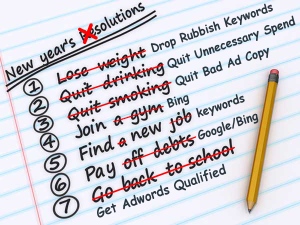It’s apparently spring (we haven’t had snow in a month so guess it must be!), so what better time to give your paid search campaigns a good ol’ spring clean?! But, “where do I start?” I hear you ask… these few pointers might just help:
1 – Pull the Plug on Under Performing Keywords
As much as we’d like to see all keywords convert well – it just doesn’t work like that. Once you’ve optimised your keywords as much as you can by adding negative keywords, tailoring ad copy to match and testing different landing pages, if you still can’t get the keyword to convert then it’s time to pull the plug. It’s like breaking up a relationship really – you really don’t want to do it but once you do, it will be the best thing you’ve ever done and you can start to move on with your life….. or something like that!
Sort your under performing keywords into two categories – the ‘no hopers’ and the ‘last chance’ keywords. Bin off the no hopers and optimise the last chance ones to do all you can to revive them. They’ll either turn into ‘no hopers’ or the ‘survive for another day’ers’ – a tad dramatic?!
Is your account full of paused keywords, ads or ad groups? If you have no intention of reactivating them, then you don’t need them cluttering up your account. Identify what you don’t need anymore and don’t be afraid to press that delete button!
3 – Review your Landing Pages
Landing pages can often be overlooked in optimising PPC accounts, but no matter how good your selection of keywords are or how great your ads look if you’re sending traffic to the wrong pages then they mean diddly squat.
Does the traffic your send to the homepage actually do anything? Is there a more relevant page you could send users to? Are you using all the possible pages? If you don’t know the answers to any of these questions, set up some A/B testing between different landing pages. Analyse the results then test another page.
4 – Add Negative Keywords
If you don’t already regularly look through your search query reports, then take the time to do so now! Search query reports show the exact queries used which trigger your ads. They are the most useful tool showing where you’re wasting your spend on keywords that are not relevant to you. Conversely, they are also useful to add the keywords triggering your ads on phrase, broad match and near exact terms as keywords in your accounts.
Plus, let’s face it, it’s always amusing to look at what people use search engines for!
5 – Look for Missed Opportunities
The opportunites tab in Google Adwords shows you where you are missing out on extra clicks and conversions either through budget constraints or by not having enough keywords in your account. This is a great tool to identify areas you can expand in, but that only tells you so much. When you work on the same accounts every day you can sometimes become blind to what is right in front of you and not spot opportunities that others may do. Ask a colleague to take a look at the account and provide any feedback on how it could be improved. You never know, you might just get some useful pointers that you hadn’t thought about – whether that’s tidying up an ad group, adding new keywords or restructuring a whole campaign.
Got any tips on spring cleaning your PPC accounts? Feel free to share them below!
Thanks for reading 🙂


